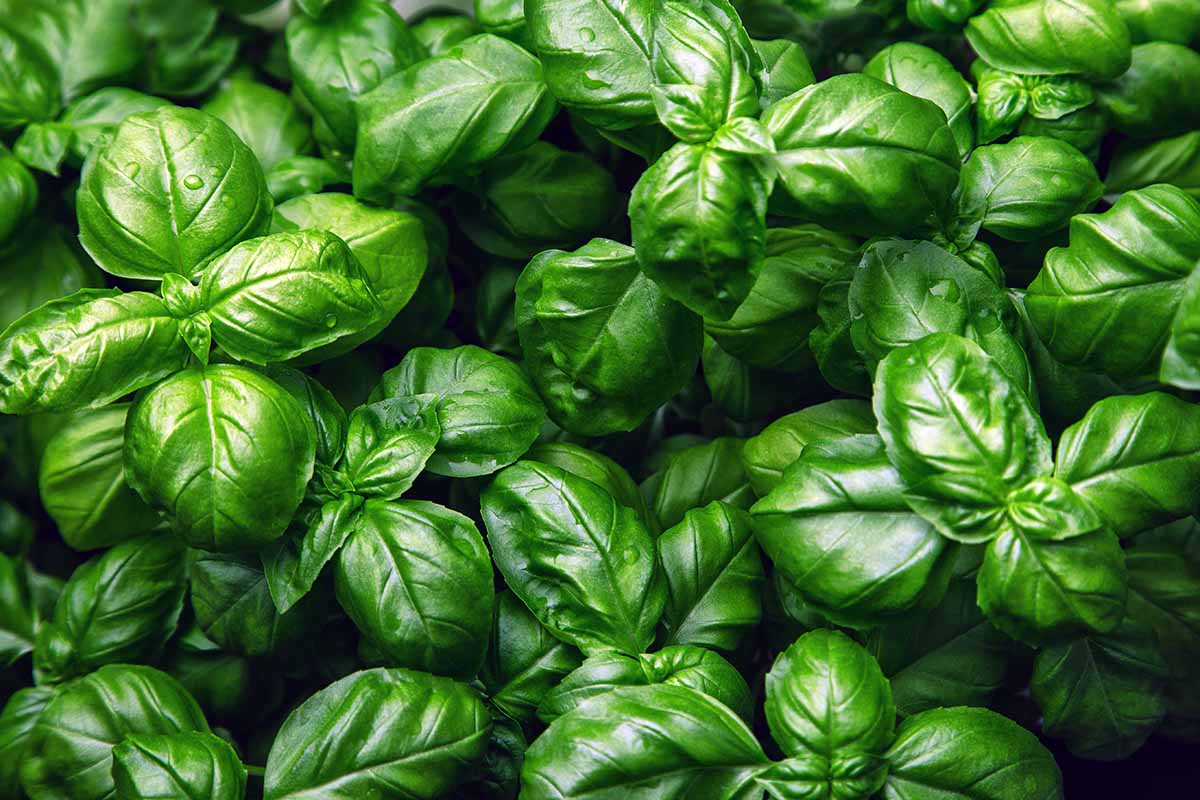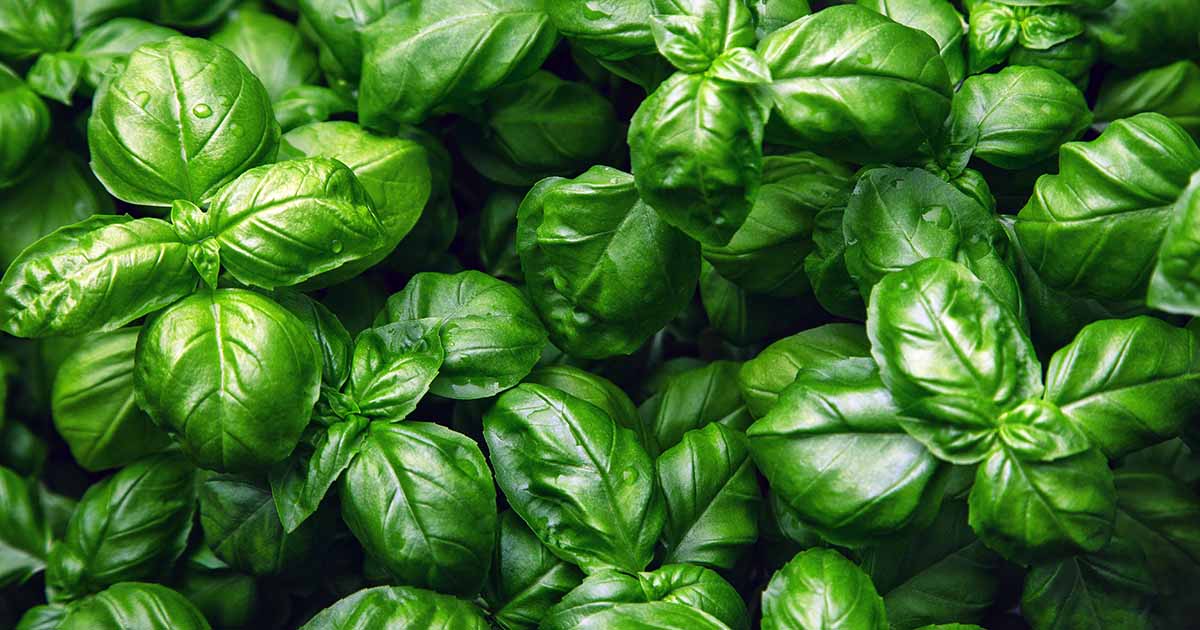Basil is a must-have herb in my kitchen garden. There’s always a pot on the windowsill during the winter and several types in my outdoor herb garden in the summer months.
Regardless of the season and the type I’m growing, it’s inevitable that I’ll be faced with a droopy, wilting plant at some point.
If you’ve ever bought a potted basil plant from the grocery store produce section that started wilting within what seemed like minutes of bringing it home, then you know what I mean.


We link to vendors to help you find relevant products. If you buy from one of our links, we may earn a commission.
There are a variety of reasons why your herbs might start looking sad.
Under- or overwatering are both common causes, but pests and diseases can also cause trouble that results in drooping and discoloration.
If you need a refresher on how to grow basil, check out our guide. In this article we’re going to go over the nine most common causes of wilt.
So if your basil is wilting or looking a bit droopy, these are the reasons why it might be happening:
9 Causes of Wilting Basil
Generally, the faster you determine the cause, the better the chances of fixing the problem and returning your basil to good health.
So let’s not waste one second more!
1. Aphids
You know them, you love them. Or maybe not.
Aphids are extremely common pests both indoors and out. They feed on basil using their sucking mouthparts, which draw out the sap, causing the foliage to wilt.


They also cause yellow stippling, stunting, and distorted growth. In addition, aphids can also spread disease, so you definitely don’t want them knocking at your door.
You’ll know it’s aphids causing the wilting as you’ll see the pests on the stems and the undersides of the leaves. You can’t miss them!
Fortunately, there are lots of ways to control aphids, from spraying them off with water from the hose to applications of insecticides like insecticidal soap and neem oil.
Read our guide to learn more about how to deal with aphids.
2. Bacterial Leaf Spot
Bacterial leaf spot, sometimes called basil shoot blight, is caused by the bacteria Pseudomonas cichorii, which thrives in humid, wet conditions.


When your herb is infected with the bacteria, you will see drooping as well as black patches on the leaves. Young shoots might also turn black and die.
The pathogen can spread in plant tissue or water, and while it didn’t used to be common in the US, this disease has been becoming more prevalent in recent years.
While you can use copper fungicide to slow the spread, there isn’t a cure, so your best bet is to dispose of the plant and the soil it is growing in and start again.
3. Dry Soil
Basil needs a lot of moisture to thrive. This herb does best if the soil is kept consistently moist at all times.
If the soil dries out, wilting is sure to follow. This is the most common cause of droopy, sad-looking plants.


If you stick your finger in the soil or roll some in your hand, it should feel like a well-wrung-out sponge.
When you squeeze the soil and it holds together, but water doesn’t squeeze out, then it’s just right. If water squeezes out it’s too wet, or the soil falls apart right away, it’s too dry.
Give your plants a good drink of water and going forwards, keep the soil moist and don’t let it dry out.
4. Fusarium Wilt
This disease is caused by the fungus Fusarium oxysporum f. sp. basilicum and when it infects your basil, it causes wilting, followed by death of the plant.
This happens because the fungus causes the tissue that conducts water through the plant to turn necrotic.


Typically, single stems will wilt while the rest of the herb looks fine. Then, the wilting areas start to turn yellow and brown before they eventually die. The wilt will then spread to the rest of the plant.
This problem is far more common outdoors than potted herbs indoors because the pathogen is soilborne. This is your reminder that you should never use garden soil when potting up your basil.
Sadly, once infected, you’ll need to toss the plant because there is no cure.
In the future, grow your herbs in clean soil when possible, and if you’ve lost basil to this disease in the past, grow resistant types like ‘Aroma’ and ‘Nufar.’
5. Heat Stress
Even plants with sufficient moisture will wilt and droop in extreme heat. Basil is pretty darn heat tolerant, and will be just fine in temperatures up to 95°F.


Now, I know what you’re thinking. My house doesn’t get that hot. But if you have your basil on a bright windowsill and the sun is being magnified through the glass, temperatures can rise rapidly.
If that’s the case, just move your basil to a different area and it should recover just fine.
Outside, if you live in a region that has super high temperatures in the summer, you might see your basil struggling during the hottest part of the really hot days.
You can provide some shade cloth from the midday sun and be sure to give them plenty of moisture.
The plants should bounce back fine provided you give them some respite from the heat and the water they need.
6. Overcrowding
If you bought one of those basil plants from the grocery store and it started drooping within days of bringing it home, it’s likely overcrowding that is causing your wilting woes.
The growers really pack the herbs in tight so the pots look full and abundant at the store. But they aren’t grown with the idea of longevity in mind.
Basil simply can’t survive in such crowded conditions as the roots have hardly any access to water or nutrients because there’s so little substrate.
The best thing to do if you buy one of those densely planted pots at the grocery store and you want to keep it longer than a week or so is to divide it up into two or three different containers with some fresh soil.
All you have to do is unpot the herb and gently pull the roots apart with some stems attached and repot them in individual four- to six-inch containers filled with soil.
They’ll expand and grow and you’ll have three healthy basil plants instead of one with its foot out the door already.
7. Overwatering
Just as dry soil can cause drooping, so can oversaturation. When there is too much water in the soil, it essentially drowns the roots, depriving them of oxygen.


As I mentioned above, the soil should feel like a well-wrung-out sponge. If you roll up a little soil into a ball and squeeze it in your hand, you shouldn’t have water dripping out.
If you’ve been overwatering, the best thing to do is stop immediately and let the soil nearly dry out before adding more. Then, be careful about how much water you provide going forward.
Also always ensure the soil is well-draining. Even if you aren’t overwatering, if the soil fails to drain properly it can cause oversaturation.
8. Root Rot
Wilting can be caused by overwatering and drowning the roots, which we talked about above.
But root rot is a step further than just too much water causing your basil to droop.
By the time root rot sets in, the roots will have turned brown and mushy and can no longer take up water or nutrients.


While overwatering is one cause, it can also be caused by the pathogens Rhizoctonia solani and Pythium spp.
Since you can’t tell which pathogen has infected your plant without sending a sample to a lab – which you’re free to do if you’d like – we just treat them in the same way.
To tackle root rot, take the herb out of its container and set it aside. Rinse the container with water and wipe it down with a 10 percent bleach solution. If your basil is growing in the ground, dig it up.
Wash the soil away from the roots and examine them closely. Cut off any rotten, brown, black, or mushy roots. Then, repot in clean, new potting soil or replant in the garden.
If you’re using potting soil, choose a product that is water retentive and airy, like Tank’s-Pro Potting Mix, which is made from organic compost and coconut coir.


Tank’s-Pro Potting Mix
You can purchase Tank’s-Pro Potting Mix from Arbico Organics in one and a half cubic foot bags.
Next, soak the soil around the plants, whether in the ground or in a container, with copper fungicide. This will kill any remaining pathogens lurking in the soil.


Bonide Copper Fungicide
Grab some Bonide Copper Fungicide at Arbico Organics, mix it with water according to the directions, and drench the soil.
Repeat this process after two weeks and again if new, healthy growth hasn’t developed.
You’re not out of the woods, yet. After repotting your plant or putting it back in the ground, be super careful not to overwater.
The pathogens need lots of moisture to thrive and reproduce. If you don’t give them that, they won’t be able to destroy your plant.
9. Spider Mites
In dry conditions, it’s possible that basil plants will face a spider mite infestation.


The first sign that these pests are around is usually the fine webbing they leave on the plants, along with yellow stippling on the foliage.
But if you don’t catch them at this phase, wilting will follow.
These tick relatives suck the sap out of plants, literally draining them of life.
As with aphids, you can usually just spray them off your basil with a gentle stream of water, but insecticidal soap and neem oil work, too.
Visit our guide to learn more about spider mites.
Stand Up Straight!
When basil wilts, not only is it a signal that something is wrong, but the leaves won’t taste very nice and the texture will be lacking as well. In other words, it ruins our feast.
Which of these dastardly foes are you facing? If you need more help determining the cause and how to fix it, feel free to hit us up in the comments section below.
Then, if you’re looking for more information about how to make the most of your basil plants, check out these guides:


